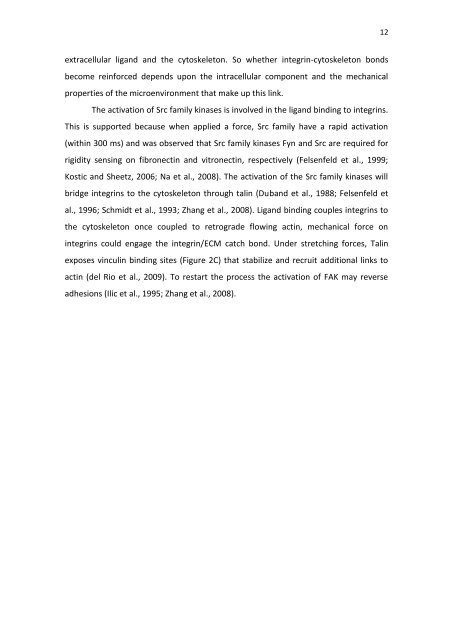DEPARTAMENTO DE CIÊNCIAS DA VIDA ... - Estudo Geral
DEPARTAMENTO DE CIÊNCIAS DA VIDA ... - Estudo Geral
DEPARTAMENTO DE CIÊNCIAS DA VIDA ... - Estudo Geral
Create successful ePaper yourself
Turn your PDF publications into a flip-book with our unique Google optimized e-Paper software.
12<br />
extracellular ligand and the cytoskeleton. So whether integrin-cytoskeleton bonds<br />
become reinforced depends upon the intracellular component and the mechanical<br />
properties of the microenvironment that make up this link.<br />
The activation of Src family kinases is involved in the ligand binding to integrins.<br />
This is supported because when applied a force, Src family have a rapid activation<br />
(within 300 ms) and was observed that Src family kinases Fyn and Src are required for<br />
rigidity sensing on fibronectin and vitronectin, respectively (Felsenfeld et al., 1999;<br />
Kostic and Sheetz, 2006; Na et al., 2008). The activation of the Src family kinases will<br />
bridge integrins to the cytoskeleton through talin (Duband et al., 1988; Felsenfeld et<br />
al., 1996; Schmidt et al., 1993; Zhang et al., 2008). Ligand binding couples integrins to<br />
the cytoskeleton once coupled to retrograde flowing actin, mechanical force on<br />
integrins could engage the integrin/ECM catch bond. Under stretching forces, Talin<br />
exposes vinculin binding sites (Figure 2C) that stabilize and recruit additional links to<br />
actin (del Rio et al., 2009). To restart the process the activation of FAK may reverse<br />
adhesions (Ilic et al., 1995; Zhang et al., 2008).
















